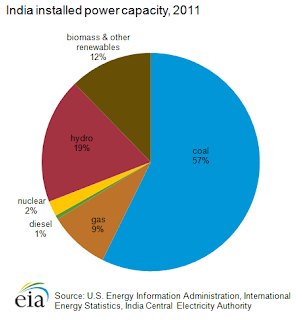Energy Saved = Money Saved + Conservation
Why
conserving Energy/Electricity is such a big need in India and or
Globally. Here are the reasons and information that helps to
understand the problem at hand and a simple solution.
Environment Conservation
While
most of us have impression that Electricity is a cleaner form of
Energy then fossil fuel, however we conveniently ignore the fact that
majority of our Electricity is generated from the fossil fuel itself.
Energy Consumption
India
stands way below the average per capita consumption of electricity
worldwide, this is not because of judicial use of electricity but
dues to the lack of availability of electricity to close to half of
its population. Data collected in 2010 suggests an estimated 48% of
rural households are yet to be electrified nationally; Bihar,
Jharkand, and Orissa have electrified fewer than 35% of rural
households large population.
In spite of this, power consumption for domestic use is very high
Cost of Generation
While
the Electricity cost is increasing at the rate of 20 to 30% year on
year, this gets passed on to the consumer in the form of increase in
electricity bill every year.
Energy Conservation
Providing
lighting only when needed is an easy and consistent way to save on
the energy bills up to the tune of 80% specially for common areas.
Areas like Staircase, corridor area, utility rooms, basements, garden
(after a specific time), attics and parking facilities that are
typically the areas where the movement or occupancy is limited. Most
of these areas in an Apartment complex are lit up continuously
between 12 to 24hrs depending on the day lighting available in these
places. The cumulative lighting need at these places may be less than
a hour in a day (depending on the utilization of the place).
A
very basis solution to solving of turning the lights 'ON' or 'OFF'
only when required can be achieved using Occupancy sensor switch or
called as smart switch. These devices can control lighting while
increasing the safety and comfort. And thus saving money by
conserving energy. Energy efficient lighting is a long-term
investment with a shorter payback period. There are various solutions
that includes supply of a single component to all-inclusive lighting
systems.
Underlying Technology
PIR (passive infrared) sensor reacts to body temperature in combination with motion. It provides light automatically when there is a requirement and it switches it 'OFF' automatically when there is no occupancy or movement.Similar to PIR sensor is microwave/ Radar based sensors. These active Radar sensors react to all types of motion faster than PIR sensors do and are more sensitive to motion.
These PIR and Ultrasonic occupancy sensors seamlessly expand from a stand-alone, low-cost energy management system to include unlimited control possibilities. These can quickly be scaled to include lighting controls, remote management, load shedding using wired or wireless applications including WiFi, Z-wave and ISM band compatible access modules. These lighting solution could be made to further interface to your Property Management Software (PMS) and Building Automation Systems (BAS).
Payback period
Payback on this investment is calculated by means of savings achieved through the savings in electricity bill, cost saved with increase in the life of the lamp.
The
basic solution could have a payback period anywhere between 1 to 2
years depending on the system selected and location of installation.
Pitfalls of Selecting wrong
There are various human presence sensor switches and lights available in the market. Most of them does the basic job of turning the light on and off initially. However the common problem with most of these sensors are
- Lamps takes longer time to
turn 'ON'
- Lamps go bad often resulting
in increase in expense on your lamps
- Angle detection problem
- Turns the light off inspite
of human presence
- Low quality parts used,
shorten the life of the switch
- Does not work well with CFL lights
About Me
I have been designing and developing Technology products and solutions for new age Homes since last 17 years. And currently promoting Smarter living solutions for South Asian homes. I have also setup first exclusive online store www.ifihomes.com focused towards the needs of Smart Homes for Indian consumers.
Email:
rohit@thekhosla.com
Website:
www.ifihomes.comSupport: care@ifihomes.com



This comment has been removed by the author.
ReplyDeleteSome of you have asked me question on how the costing works. Below information is for your better understanding.
ReplyDeleteCost of implementation depends on
a) Quantity & Sensor model Selected
b) Wiring & Installation Cost
c) If any complete management system selected
In case of Standalone sensor to manage individual light, it would be mainly "a" as the cost with small "b" cost
While if same standalone sensor is used for turning multiple lights "ON", then wiring cost increases for sure however quantity of sensor would reduce. This would surely bring down the overall cost but depends on the elevation of common area and wiring of lights.
Easy method of calculating total project cost is number of lights multiplied by the sensor cost (assuming 1 sensor per light, which is a worst case scenario). This would however give you some idea on upper limit for the numbers
Smart Livingis a trend encompassing advancements that give people the opportunity to benefit from new ways of living.
ReplyDelete